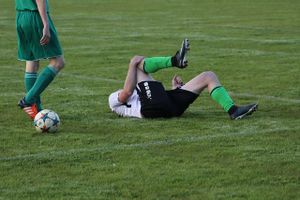Overuse Injuries in Sport
Original Editor - Wanda van Niekerk
Top Contributors - Wanda van Niekerk, Kim Jackson and Jess Bell
Introduction[edit | edit source]
Overuse injuries are a common phenomenon in sports and challenging to assess and manage. Various factors contribute to the development of these type of injuries. The diagnosis, treatment and understanding why the injury occurred are some of the challenges that clinicians may deal with in the management of athletes with overuse injuries.
Definition of Overuse Injury[edit | edit source]
The term “overuse injury” is a broad term used to describe an injury caused by repeated micro-trauma, rather than a specific or single injury event. The term "overuse" is used as the onset of these type of injuries are usually precipitated by a period of inappropriate tissue loading such as[1]:
- Excessive magnitude or volume of load
- Insufficient recovery between bouts of load
An overuse injury is usually caused by repetitive activities over a period of time. It is often due to excessive and repetitive loading of the specific tissue with a gradual onset of symptoms. During the early stages of the injury, there is little or no pain and the athlete might unknowingly continue to place pressure on the injured area. As a result, the area does not have the necessary time to heal. The cause of an overuse injury is often less obvious, compared to the macro-trauma of an acute injury. The principle in overuse injury is that the repetitive microtrauma overloads the capacity of the tissue to repair itself. During exercise, the various tissues such as muscles, tendons, bones and ligaments, are being loaded and experience excessive physiological stress. After the specific exercise activity, the tissues undergo adaptation in order to strengthen and to be able to withstand similar stress in the future. If the adaptive capability of a specific tissue type is exceeded and injury occurs, this is most often an overuse injury. Therefore, in overzealous athletes, that do not allow adequate time for adaptation to occur before the next workout or training session, the cumulative tissue damage eventually exceeds the threshold that the tissue can handle and this causes pain and dysfunction.[1]
Other terms related to the term overuse injury include:
- Gradual onset injury
- Overuse syndrome
- Sports disease
- Cumulative trauma disorders
- Repetitive strain injuries
Overuse vs Training Error?[edit | edit source]
In the article, Time to Bin the Term “Overuse Injury”: Is “Training Error” a more accurate term? Drew and Purdam (2016) propose that the term ‘errors in training load prescription’ is more reflective of what occurs in injuries that until now have been viewed as ‘overuse’.[2] The authors suggest that the use of the term ‘overuse’ may in fact encourage athletes to reduce their training load, exposing their tissues to deconditioning or an inconsistent loading patterns, which have been associated with injuries.[2] Recently, in the Discussion section of the British Journal of Sports Medicine, Kalkhoven et al (2020) raised concern about replacing the term ‘overuse injuries’ with the term ‘training load error.” In the article: Training load error is not a more accurate term than overuse injury, the authors reason that training load is just one of the many factors that may contribute to overuse injuries and that “defining overuse injuries as training load errors is a negation of their multifactorial nature.”[3]
Risk Factors of Overuse Injury[edit | edit source]
Training loads, intense competition schedules and inadequate or insufficient recovery are some of the factors that place athletes at higher risk for developing an overuse injury. Risk factors can also be classified according to intrinsic and extrinsic risk factors[4]:
Intrinsic Risk Factors[edit | edit source]
- Malalignment issues, such as gena valgum or varum, patella alta, femoral neck anteversion
- Leg length discrepancy
- Muscle imbalance
- Muscle weakness
- Flexibility issues, such as generalised muscle tightness, restricted joint range of motion
- Body composition
Extrinsic Risk Factors[edit | edit source]
- Training load errors, such as excessive volume, intensity, increase, inadequate recovery
- Surfaces
- Shoes
- Equipment
- Environmental conditions
- Nutrition
- Psychological factors
Consequences of Overuse Injuries[edit | edit source]
Consequences of overuse injuries include:
- Pain
- Reduced physical performance
- Reduced sports participation
- This influences the athlete, but also the team and sports organisations a well
- There are also direct and indirect costs involved in the treatment of overuse injuries
- Overuse injuries often lead to an athlete’s premature retirement from his/her sporting career
- An athlete may still be symptomatic even after the end of their sporting career.
- Overuse injuries pose as a barrier to physical activity even in less-athletic populations, and this has consequences for long term health and quality of life.
Structures affected by Overuse Injuries[edit | edit source]
Various body structures can be affected by sport-related overuse injuries, such as[5]:
- Bones
- e.g. stress fractures
- Muscle
- e.g. focal tissue thickening/fibrosis
- chronic compartment syndrome
- Tendon
- Fascia
- Bursae
- e.g. bursitis
- Nerve
- e.g. nerve entrapment syndromes
Management of Overuse Injuries[edit | edit source]
Diagnosis[edit | edit source]
The diagnosis of overuse injuries require[5]:
- Comprehensive history of the onset, nature and site of pain
- Thorough assessment of potential risk factors, such as training and technique
- Examination of the specific anatomical structure
Stages of Overuse Injuries[edit | edit source]
- Discomfort disappears during warm-up
- Discomfort may disappear during warm-up but resurfaces at the end of the activity
- Discomfort at the onset of activity and worsens during activity
- Pain and/or discomfort all the time
Treatment of Overuse Injuries[edit | edit source]
Important aims of treatment of overuse injuries[5]:
- identify and address the cause of injury
- reduce inflammation and pain
- promote healing
- prevent complications
- restore normal use of the injured area
- develop a return to sport strategy, as dictated by symptoms
Treatment of overuse injuries may include[5]:
- relative rest and avoidance of aggravating activities while maintaining fitness
- use of ice and electrotherapeutic modalities
- soft tissue techniques
- strengthening and rehabilitation
- medication, such as NSAID's
Overuse Injury Surveillance[edit | edit source]
Many of the injury surveillance research provide information predominantly on acute sports injuries and often do not account for overuse injuries in sport. The reason for this being that many traditional sports injury surveillance studies make use of "time loss" from sports as the most important criteria for defining the occurrence of an injury and the duration of the "time loss" is used as a measure of the severity of the injury. By using these methods, the impact of overuse injuries in athletes is underestimated, as many athletes continue to train and compete, despite having injury-associated symptoms and limitations.[9] Clarsen et al (2013) developed a new model of injury surveillance, which also allows for the review of the prevalence of overuse injuries (i.e. the magnitude, symptoms and consequences of overuse injuries) - the Oslo Sports Trauma Research Center Overuse Injury Questionnaire (OSTRC-O).[10] An updated version of the Oslo Sports Trauma Research Center Overuse Injury Questionnaire (OSTRC-O2) was recently published.[9] The four domains that the OSTRC-O evaluates include[9]:
- sports participation
- training volume
- sports performance
- pain
Clinicians and researchers can administer the questionnaire at regular intervals (e.g. weekly) and are able to monitor how the consequences of an overuse injury change over time.
A modified version of the OSTRC-O was also developed to monitor all types of health problems in athletes - the OSTRC Questionnaire on Health Problems (OSTRC-H) and also recently updated to the OSTRC-H2 version.[9]
References[edit | edit source]
- ↑ 1.0 1.1 Clarsen B. Overuse injuries in sport: development, validation and application of a new surveillance method.(dissertation). Oslo Sports Trauma Research Centre. Norwegian School of Sports Sciences. 2015.
- ↑ 2.0 2.1 Drew MK, Purdam C. Time to bin the term ‘overuse’injury: is ‘training load error’a more accurate term?. British journal of sports medicine. 2016 Nov 1;50(22):1423-4.
- ↑ Kalkhoven J, Coutts AJ, Impellizzeri FM. ‘Training load error’is not a more accurate term than ‘overuse’injury. British Journal of Sports Medicine. 2020 Feb 24.
- ↑ DiFiori JP, Benjamin HJ, Brenner JS, Gregory A, Jayanthi N, Landry GL, Luke A. Overuse injuries and burnout in youth sports: a position statement from the American Medical Society for Sports Medicine. British journal of sports medicine. 2014 Feb 1;48(4):287-8.
- ↑ 5.0 5.1 5.2 5.3 Brukner P. Brukner & Khan's Clinical Sports Medicine. North Ryde: McGraw-Hill; 2012.
- ↑ CHOC Children's. When an Athlete Has an Overuse Injury - Dr. Jonathan Minor. Published on 24 July 2017. Available from https://www.youtube.com/watch?v=x9InVjF6aP8 (last accessed 6 September 2020)
- ↑ Spectrum Health. Treating an overuse injury. Published on 8 September 2015. Available from https://www.youtube.com/watch?v=sUqQEHlCK_E&t=6s (last accessed 6 September 2020)
- ↑ St Louis Children's Hospital. Overuse Injuries in Sports | Parenting Resources. Published on 5 April 2019. Available from https://www.youtube.com/watch?v=VqZg0eJpvOI&t=36s (last accessed 6 September 2020)
- ↑ 9.0 9.1 9.2 9.3 Clarsen B, Bahr R, Myklebust G, Andersson SH, Docking SI, Drew M, Finch CF, Fortington LV, Harøy J, Khan KM, Moreau B. Improved reporting of overuse injuries and health problems in sport: an update of the Oslo sport trauma research center questionnaires. British journal of sports medicine. 2020 Apr 1;54(7):390-6.
- ↑ Clarsen B, Myklebust G, Bahr R. Development and validation of a new method for the registration of overuse injuries in sports injury epidemiology: the Oslo Sports Trauma Research Centre (OSTRC) overuse injury questionnaire. British journal of sports medicine. 2013 May 1;47(8):495-502.
- ↑ Sportskongres. Ben Clarsen on challenges of recording overuse injuries. Published on 24 January 2020. Available from https://www.youtube.com/watch?v=sU-vVzixmmw. (last accessed 6 September 2020)








